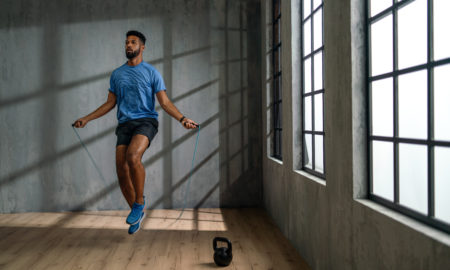The “hyper”—short for hyperextension—is still a common exercise in commercial gyms, heavy gyms, high school and college weight rooms, as well as weightlifting clubs. In some circles the older name of “hypers” has been replaced by “back raises.” I’m not so sure that’s a good replacement for a fundamental exercise.
The hyper is performed today on a hyperextension bench, which can be horizontal or at a 45 degree angle. The horizontal hyper originated in the Eastern Bloc countries to increase the back strength of their weightlifters. It was performed while lying across the width of a gymnastic vaulting horse with the feet braced against brackets on a wall. In some cases coaches would help hold the athletes’ feet or lower legs in place to counter the heavy weight they were using. The weightlifters would bend forward at the hips until their upper body was hanging straight down. Then they’d raise it at the hip joint until it was parallel and arch, or hyperextend, the spine to raise it farther—hence the term “hyperextension.”
The Eastern Bloc lifters amazed everyone with the amount of weight they used for hypers. I saw photos of Bulgarian athletes in what was then the 148-pound class holding 90 pounds behind their heads while performing the exercise. Vasily Alexeev, a former multi-world-record holder in the superheavyweight class, performed hypers with 315 pounds for five reps.
The hyper is a tremendous exercise for the hamstrings, the gluteus maximus and the lower-back muscles. For that reason it crossed over and became a popular exercise in track and field, football and also in bodybuilding. As more and more trainees performed hyperextensiions, many found that hyperextending the spine caused lower-back pain. If, however, they only performed the “hyper” to neutral—that is, raised their hips to a straight line position—they would often be pain free. I have seen that many times in athletes. The usual cause of pain from hyperextending the spine is compression, or jamming, of joints in the spine known as facet joints. They guide the movement of the spine and can generate pain and/or enlarge from long-term compression. Further compression of the facet joints from the hyperextension of the spine leads to pain.
When the hyper became popular, most trainees didn’t want to lie across a vaulting horse, so hyperextension benches were created. The first ones were horizontal with pads for the heels and the feet blocked. You could now do hypers without a helper. Even so, the exercise was still considered advanced, especially if performed with weight. A new bench was created that was easier to use, and beginners found it comfortable. It was set at 45 degrees instead of parallel, as shown in the accompanying photo.
As you can see, your feet are at the base of the bench so your legs are weight bearing, and there’s a pad to lock your heels in place. The 45 degree angle is easier to perform the movement from and seems to teach you to bend forward from the hips rather than round your back.
The hamstrings and gluteal muscles contract powerfully to perform a common hyper movement. The back muscles along the spine are in isometric contraction if the spine remains still, but they will contract more if you hyperextend the spine.
You can perform sets that are a little higher in reps if you’re not using weight. Working up to a couple of sets of 10 reps without weight is tolerable. Once you reach that point, it’s time to add weight. You can start with a plate held either behind your head or in front of your chest and shoulders. Holding the weight in front is fine, but beware that you’ll be able to handle more weight that way, as the leverage is better. Once you start adding weight to lower-back movements, you need to cap the volume. Keep your sets to five reps or fewer. A couple of sets of five reps twice per week are more than enough for this exercise.
As always, train smart, then train hard.
Editor’s note: Visit www.SoftTissueCenter.com for reprints of Horrigan’s past Sportsmedicine columns that have appeared in IRON MAN. You can order the books Strength, Conditioning and Injury Prevention for Hockey by Joseph Horrigan, D.C., and E.J. “Doc” Kreis, D.A., and The 7-Minute Rotator Cuff Solution by Horrigan and Jerry Robinson from Home Gym Warehouse, (800) 447-0008, or at www.Home-Gym.com.




















You must be logged in to post a comment Login